2015 江苏南京航空航天大学基础英语考研真题
I. Vocabulary (20 points)
A. Choose the word or phrase marked A, B, C, and D to best correspond to the word
above. Be sure to write down your choice on the answer sheet. (10 points)
1. stupendous
a) astonishingly large b) surprisingly stupid
c) astonishingly small d) surprisingly heady
2. scamper
a) jog b) scurry
c) saunter d) stroll
3. cataract
a) stream b) water flow
c) deluge d) river
4. derelict
a) forsaken b) foretold
c) forbidden d) foreseen
5. idyllic
a) worshipping b) blissfully peaceful and happy
c) worshipped d) happy and pleasant
6. adversary
a) opponent b) adherent
c) proponent d) adviser
7. rendezvous
a) place for a fight b) place for a tour
c) place for a drink d) place for a meeting
8. modulate
a) vary the length b) vary the height
c) vary the intensity d) vary the width
9. deity
a) devil b) demon
c) god or goddess d) ghost
10. belligerent
a) hostile b) awesome
c) aggressive d) pugnacious
B. Directions: Explain the italicized words in the following sentences with simple,
everyday words or expressions in English. Be sure to write down your explanation
on the answer sheet. (10 points)
1. Shopkeepers dealing in the same kind of goods collect in the same area, so that
purchasers can know where to find them.
2. I see the Russian soldiers standing on the threshold of their native land, guarding
the fields which their fathers have tilled from time immemorial.
3. It is the existence of the child, and their knowledge of its existence that makes
possible the poignancy of their music.
�
4. It is as if some titanic and aberrant genius, uncompromisingly inimical to man,
had devoted all the ingenuity of Hell to the making of them.
5. I was standing in the sun on the hot steel deck of a fishing-ship capable of
processing a fifty-ton catch on a good day.
6. On the river, Twain found the ultimate expression of escape from life’s
regularities and the energy-sapping clamor for success.
7. Even the most incorrigible maverick has to be born somewhere.
8. Johnny Carson has much to do to keep up with my quick and witty tongue.
9. This is why the spread of technology makes the world look ever more homogeneous.
10. I thought that Hiroshima still felt the impact of the atomic cataclysm.
II. Cloze (20 points)
A. Fill in each of the following blanks with a suitable word in its proper form and
write down the required word on the answer sheet. (10 points)
In the midst of a glorious summer day, I returned home to find my husband_1_, legs
dangling off our bed, looking for the world as_2_he had lost his best friend. In
a way, he had. When queried about his mood, he simply 3 , “Everybody hates me.”
We had been experiencing 4 of those weeks as parents when nobody understands the
language you’re speaking – and it was taking 5 toll!
My husband is not prone 6 moodiness, or worrying too much about 7 likes him and who
doesn’t. The military taught him that 8 over the course of more than twenty 9 .
His last assignment in the military was 10 a Company Commander training recruits
in the basic rudiments of the military way. This particular 11 demands a no nonsense
style of authority and discipline – and he 12 this well. Why then were a few 13
giving him so many problems?
While doing his job, Paul understood that recruits are not supposed to 14 you when
doing your job well - one of the qualities that 15 him outstanding at his job.
Unfortunately, Paul, like most 16 parents, expects to discipline their children and
have 17 like us; not only 18 that expectationunrealistic, it can make us terribly
ineffective at our jobs as parents. In the long 19 , it is the guideline we lay down
for children 20 cultivates a lasting love, respect and security as they grow.
B. Fill in each blank with a proper word from the following box. Change its form
if necessary and write down the required word on the answer sheet. (10 points)
One of the most important new methodologies is biomechanics, the study of the body
in motion. A 1 films an athlete in 2 and then digitizes her performance, 3 the motion
of every joint and 4 in three dimensions. By 5 Newton’s law to these motions, ‘we
can say that this athlete’s run is not fast enough; that he is not using his arms
6 enough during take-off,’ says Dapena, who uses these methods to help high jumpers.
To 7 , however, biomechanics has made only a small 8 to athletic performance.
Revolutionary ideas still come from the athletes themselves. For example, during
the 1968 Olympics in Mexico City, a 9 unknown high jumper named Dick Fosbury won
�
the gold by going over the bar 10 , in complete contradiction of all the 11
high-jumping wisdom, a move instantly 12 the Fosbury flop. Fosbury himself did not
know what he was doing. That understanding took the 13 analysis of biomechanics
specialists, who put their minds to comprehending something that was too complex
and unorthodox 14 to have been invented through their own mathematical simulations.
Fosbury also required another 15 that lies behind many improvements in 16 performance:
an innovation in athletic equipment. In Fosbury’s 17 , it was the cushions that
jumpers land on. Traditionally, high jumpers would land in pits 18 with sawdust.
But by Fosbury’s time, sawdust pits had been replaced by soft foam cushions, 19
for flopping. In the end, most people who examine human performance are humbled by
the 20 of athletes and the powers of the human body.
III. Error correction (20 points)
Directions: There are twenty mistakes in the following passage. You are required
to underline or mark themistakes and get them corrected. Be sure to write down the
correct form on the answer sheet.
Example: “Wordsworth is said to have ∨ most fascinating voice!” the
In modern times law is required by any society for its steadily development. 1_______
And law develops with society evolves. But what is law? 2_______
Law is a body of official rules and regulations, general found in
constitutions,3_______
legislation, judicial opinions, and like. Law is used to govern a society and
4_______
controlling the behavior of its members. The nature and functions of law 5_______
are varied throughout history. In modern societies, some authorized body such
as6_______
a legislature or a court make the law. It is backed by the coercive power of
the7_______
state, which enforces the law by mean of appropriate penalties or remedies. 8_______
Formal legal rules and actions are usually distinguished by other means of 9_______
social control and guides for behave such as mores, morality, public opinion, and
10 _______
custom or tradition. Of course, a lawmaker may respond public opinion or other
11_______
pressures, and a formal law may prohibit which is morally unacceptable. 12_______
Law serves the variety of functions. Laws against crimes, for example, help to
13_______
maintain a peacefully, orderly, relatively stable society. Courts contribute to
social 14_______
stability by resolving disputes in a civilize fashion. Property and contract laws
15_______
facilitate business activities and private planning. Laws limited the powers of
16_______
government help to provide some degree of freedom that will not otherwise be
17_______
�
possible. Law has also being used as a mechanism for social change; for instance,
18_______
at various times laws have been passing to inhibit social discrimination and to
19_______
improve the quality of individual life in matter of health, education, and
welfare.20_______
IV. Paraphrase (30 points)
Directions: Restate the following sentences in another form in English to clarify
the meaning. Be sure to write down your restatement on the answer sheet.
1. They narrow down their choice and begin the really serious business of beating
the price down.
2. We seem oblivious of the fragility of the earth’s natural systems.
3. Let us redouble our exertions, and strike with united strength while life and
power remain.
4. He became obsessed with the frailties of the human race.
5. Lexicography, like God, is no respecter of persons.
6. The developing nations are bent on taking over the lion's share of the trade.
7. On certain levels of the American race there seems to be a positive libido for
the ugly.
8. Let both sides seek to invoke the wonders of science instead of its terrors.
9. It is going to pay off in cold dollars and cents to management.
10. Science has thus undermined an article of faith: the thingliness of things.
V. General Knowledge (20 points)
a. Directions: Choose the best to fill in the blank or answer the question.(10 points)
1. The sentence structure is ______.
A. only linear
B. only hierarchical
C. complex
D. both linear and hierarchical
2. Macbeth, Hamlet, King Lear and ________ are categorized as “Four tragedies”
by William Shakespeare.
A. Romeo and Juliet
B. All’s Well That Ends Well
C. Othello
D. The Tempest
3.“We shall know a word by the company it keeps.”This statement represents _______.
A. the conceptualist view
B. contextualism
C. the naming theory
D. behaviorism
4. Which one is NOT the characteristic of neoclassicism?
A. rationality
B. imagination
C. restraint
�
D. order
5. “Can I borrow your bike?” ________ “You have a bike”.
A. is synonymous with
B. is consistent with
C. entails
D. presupposes
6. _______ , the author of The Sketch Book, is often called “the father of American
literature.”
A. Washington Irving
B. Nathaniel Hawthorne
C. Herman Melville
D. Edgar Allan Poe
7. Which of the following is NOT true?
A. Sense is concerned with the inherent meaning of the linguistic form.
B. Sense is the collection of all the features of the linguistic form.
C. Sense if abstract and decontextualized.
D. Sense is the aspect of meaning dictionary compilers are not interested in.
8. The Canadian writer Alice Munro, who won the 2013 Nobel Prize in Literature, is
known as a__________.
A. dramatist
B. short story writer
C. novelist
D. poet
9. Chomsky studies language from a psychological point of view, holding that language
is a form of_____; while Halliday focuses on the social aspect of language, regarding
language as a form of________.
A. knowing, doing
B. knowing, thinking
C. thinking, doing
D. doing, knowing
10. The American playwright Tennessee Williams’ famous play _________ depicts the
fading of a Southern belle who clings tightly to the Southern decorum.
A. Death of a Salesman
B. Desire Under the Elms
C. A Street Car Named Desire
D. The Adding Machine
b. Directions: Candidates are FREE to choose any FIVE from the following TEN terms
and explain them in plain English on the answer sheet. (10 points)
1. illocutionary act
2. phonology
3. interlanguage
4. metaphor
5. displacement
6. bildungsroman
�
7. blank verse
8. first-person narrative
9. tragicomedy
10. humanism
VI. Reading Comprehension (40 points)
Directions: Each of the passages below is followed by some questions. For each
question there are four answers marked[A][, B][, C]or[D]. Read the passages
carefully and choose the best answer to each of the questions.
Be sure to write down your choice on the answer sheet.
Passage A
There are two realities about the current Ebola epidemic in West Africa — one from
inside the infectedzone, and another from outside of it.
Outside the zone, a miracle drug — ZMapp, or some iteration of it — is just around
the corner, to sweep the problem away. The Western narrative of scientific progress
demands no less. Inside the zone, fearful villagers and city dwellers continue to
hide sick relatives, cross borders carrying the infection and touch infected corpses
at funerals. More become infected, and more die. The epidemic, not science, advances.
Outside the zone, somebody else must be to blame for the worst Ebola epidemic in
history: the United States or Europe, for not providing enough help or money, or
international health agencies, for not committing enough resources or for not having
stamped it out already. Inside the zone, attention is focused on staying alive
and coping, not blaming. Inside the zone, Doctors Without Borders, a largely European
organization, is stretched to the breaking point and is forced to turn away Ebola
patients, the United States government’s Centers for Disease Control and Prevention
has committed scientists to the anti-Ebola fight — dozens have been deployed to
the region, according to the C.D.C. — and even the maligned World Health
Organization has sent in doctors, epidemiologists and health workers who are putting
themselves at risk.
Outside the zone, hysteria over Ebola has led to the collective stigmatization of
a big chunk of the African continent. Anybody coming from West Africa is suspected
of carrying the disease. Inside the zone, life goes on, and people shop in markets
— if not quite as normal, then at least as much so as human survival mechanisms
will allow. Near the gates of the Ebola treatment center in Guéckédou, Guinea, for
instance, where the epidemic started, a licentious-looking bar called the “Deuxième
Bureau” — “Second Office,” a local reference to the house of a kept woman or
mistress — was still welcoming customers in mid-July, even as dying Ebola patients
were being ferried past.
The clash of these two realities is to be expected, given the extreme circumstances.
It is like this when one disadvantaged corner of the world is beset by a calamity,
and the rest of the world peers in, anxiously and imperfectly, from a vantage point
in which no one worries about relative order, a constant supply of electricity
and running water, and air-conditioning. But the contrast is particularly striking
this time because there is no risk in simply stepping off the few remaining planes
flying in to Freetown, Conakry or Monrovia — contrary to what some in the West
�
appear to believe.
Yet here is where the two narratives join up: because there is real fear, inside
and outside the zone. Inside the Ebola zone, the fear is based on a potent reality.
Ebola kills about half its victims, the epidemic is so far unchecked, and the medical
resources on the ground, largely sent in from elsewhere, are not keeping pace. In
fact they are losing ground.
That truth is difficult for people in the West to grasp. The misapprehension is
comprehensible, because one of the world’s deadliest viruses is afflicting the
weakest, least-prepared societies in the world. The consequences of such a
confrontation cannot be anything other than fearsome. Nothing now stands in the way
of the disease except the overstretched foreign aid agencies.
It is difficult for people in the West to imagine the extent of disorganization in
these countries. There is a near-total absence of effectively functioning
institutions of any sort, let alone those devoted to health care.
Years of exploitation by thieving elites — followed by brutal civil wars that were
in some ways the inevitable consequence — substituted for institution- and
nation-building in Liberia and Sierra Leone, the two hardest-hit countries. In
Guinea, a sinister, ideologically motivated dictator ruled his country with an iron
hand for a quarter century. The lesson for the country’s beleaguered inhabitants
was the same as in its neighbors, a lesson now playing out with awful consequences:
The state and institutions were always sources of suffering, not succor.
1. There are many things that western people fail to understand about West Africa
except _____.
A. The extent of chaos of the countries in West Africa.
B. The truth about the epidemic in West Africa.
C. Anybody coming from West Africa is suspected of carrying the disease.
D. The inefficiency of the countries in West Africa in dealing with the epidemic.
2. According to the article, which of the following statements is TRUE?
A. People inside the zone are exposed to the Ebola directly.
B. People outside the zone are not afraid of the Ebola because they are very well
protected.
C. The Ebola epidemic divides Africa into two contrasting worlds.
D. People inside the zone are forced to stay within their own houses most of time.
3. According to the text, who was/were to blame for the worst Ebola epidemic in
history?
A. Villagers and city citizens who get panicked.
B. The Western narrative.
C. USA and UN.
D. International health agencies.
4. What is the difference between the two zones?
A. Outside the zone, people are immune to the Ebola epidemic, and inside the zone,
people are afflicted wit Ebola severely.
B. The inside zone is more hazardous than the outside zone.
C. White people in West Africa mainly lived outside the zone, and black people lived
�
inside the zone.
D. People outside the zone have a sense of superiority to those living inside the
zone.
5. Why is Ebola so severe and fearsome for people in West Africa?
A. The epidemic kills more than 50 percent of people who suffer from it.
B. The epidemic has not been successfully diagnosed throughout the world.
C. People are not very clear of the fact how the epidemic spreads.
D. Nothing and nobody except foreign aid agencies can possibly prevent the epidemic
from spreading effectively.
Passage B
In an ocean popularity contest, jellyfish would rank near the bottom. They sting.
Their increasing population blooms clog power plant intakes, kill farmed salmon and
frighten swimmers. Experts warn of the jellification of the oceans.
True, jellyfish are biological marvels and efficient swimmers, and some achieve a
kind of immortality. But they are by definition gelatinous — you might even say
gooey — and scientists have spotted them blanketing the ocean floor after die-offs,
suggesting that even for indiscriminating scavengers, jellies are not the carrion
of choice.
However, the first experimental test involving a dead-jellyfish buffet tells a
completely different story.
Work done in Norway by Andrew Sweetman of the International Research Institute of
Stavanger and his
colleagues suggests that the impression left by previous ocean-floor observations
may be the exception, not the rule.
They sank platforms loaded with jellyfish and other platforms loaded with mackerel
more than 4,000 feet deep in the Sognefjord, Norway’s largest fjord. And what they
found was that the seafloor cleanup crew —hagfish, crabs and other creatures —
gobbled up the jellyfish just as fast as the mackerel, within a few hours.
The result was so surprising, Dr. Sweetman said, that the first time the researchers
pulled up a bare platform after 18 hours at the bottom of the fjord, “we thought
the jellyfish just washed off on the way down.”
Then they checked the video. “None of us could believe it,” he said. “It went
against everything we thought.”He said,“You can actually see the hagfish burrowing
in and eating the energy-rich gonads.”
Two kinds of jellyfish, helmet and lion’s mane, were used, and Atlantic mackerel.
The researchers matched the amounts they put on the platforms and the size of the
pieces. Scavengers arrived in minutes and usually finished the jellyfish in one to
two hours and the mackerel in around eight hours.“This is exciting work,” said
David Billett, a visiting research fellow at the National Oceanography Center in
Southampton, England. In an email, Dr. Billett, who was not involved in the
experiments, wrote, “It provides the first direct evidence that when jellyfish die,
they don’t just fall to the bottom of the ocean as a pile of mush, but provide
much-needed sustenance for a wide variety of deep-sea animals.”
The cases where jellyfish blanket the bottom, Dr. Billett said, may be rare events,
�
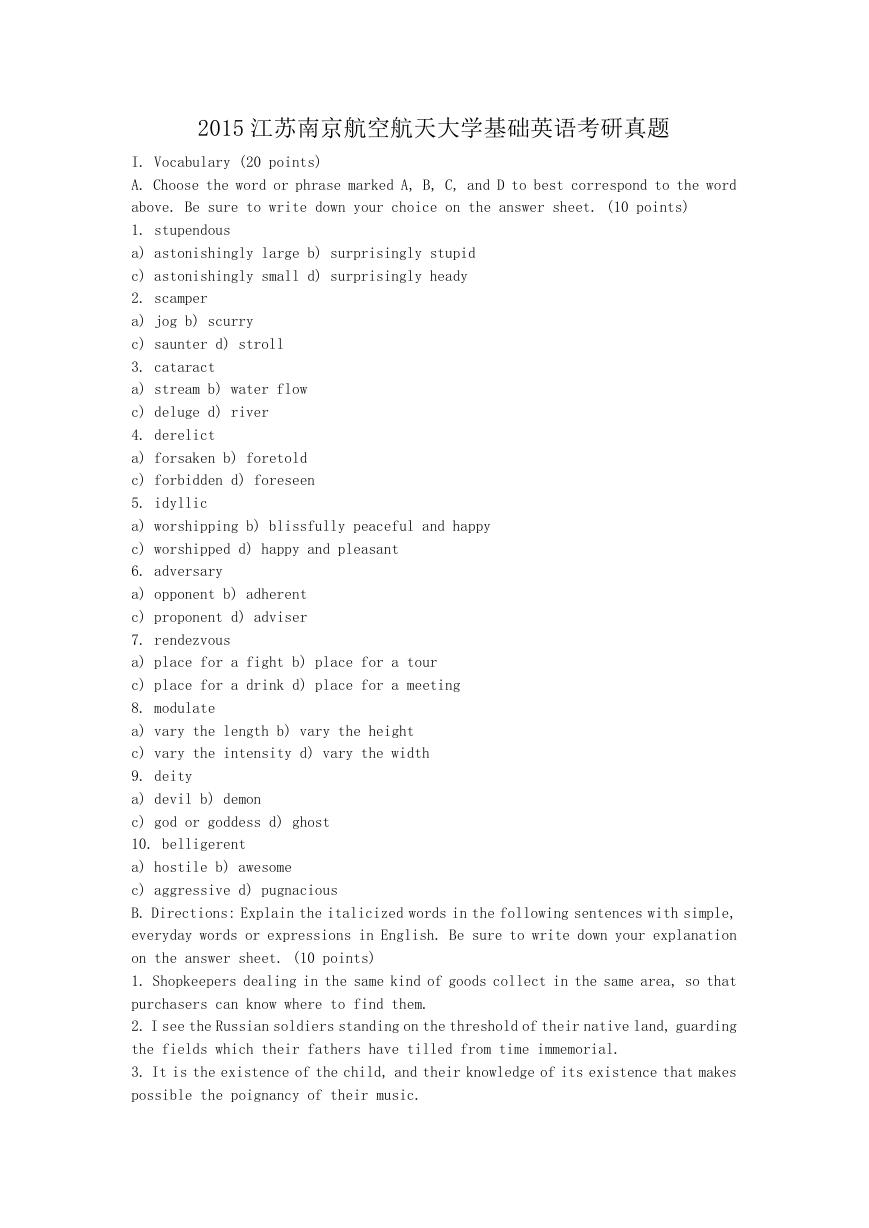
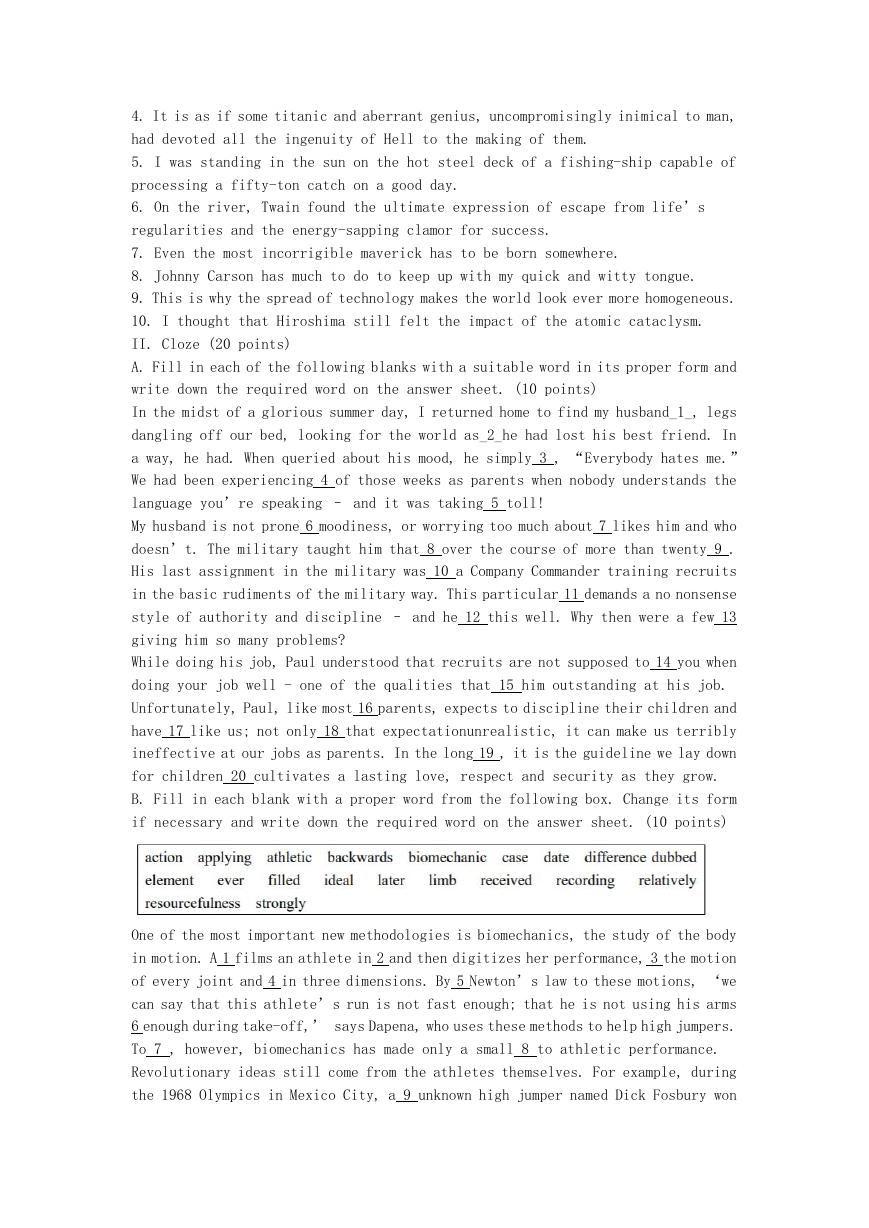
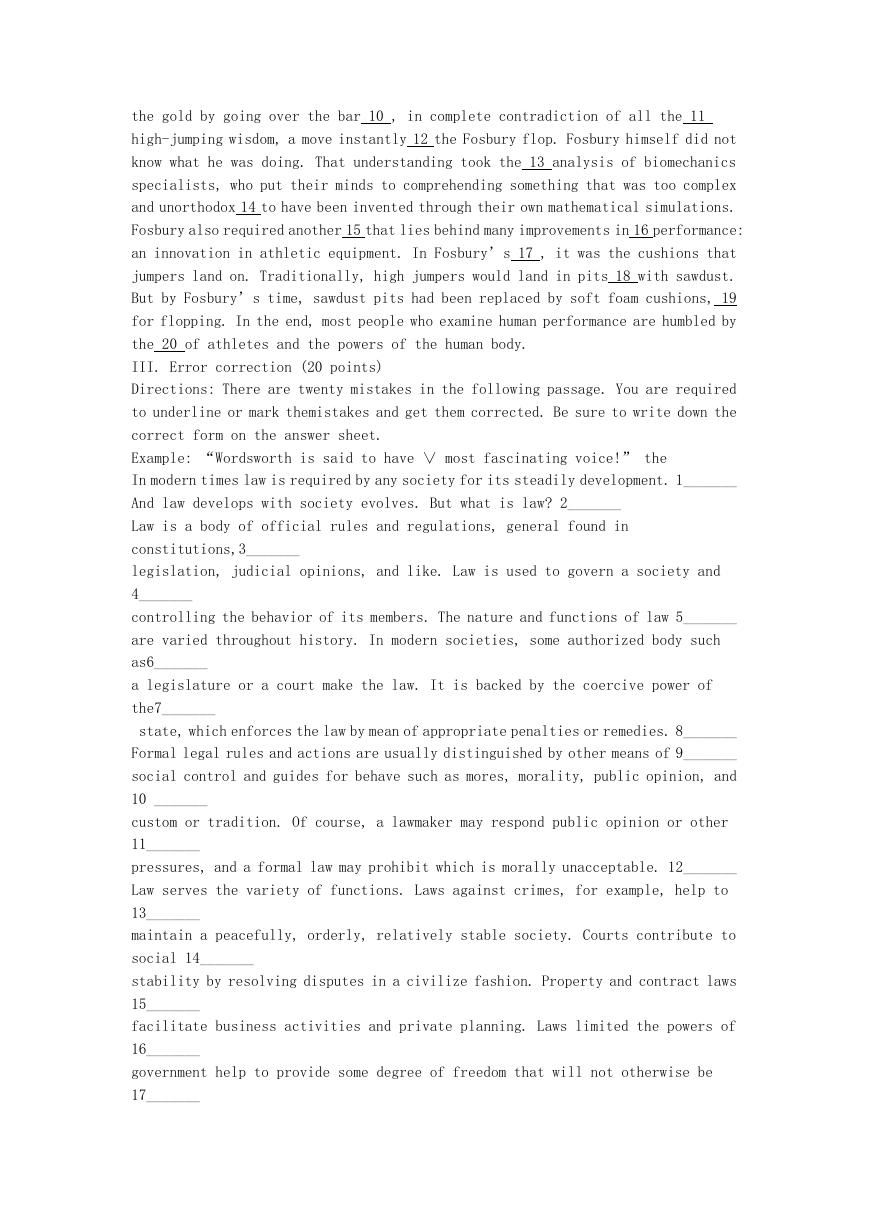
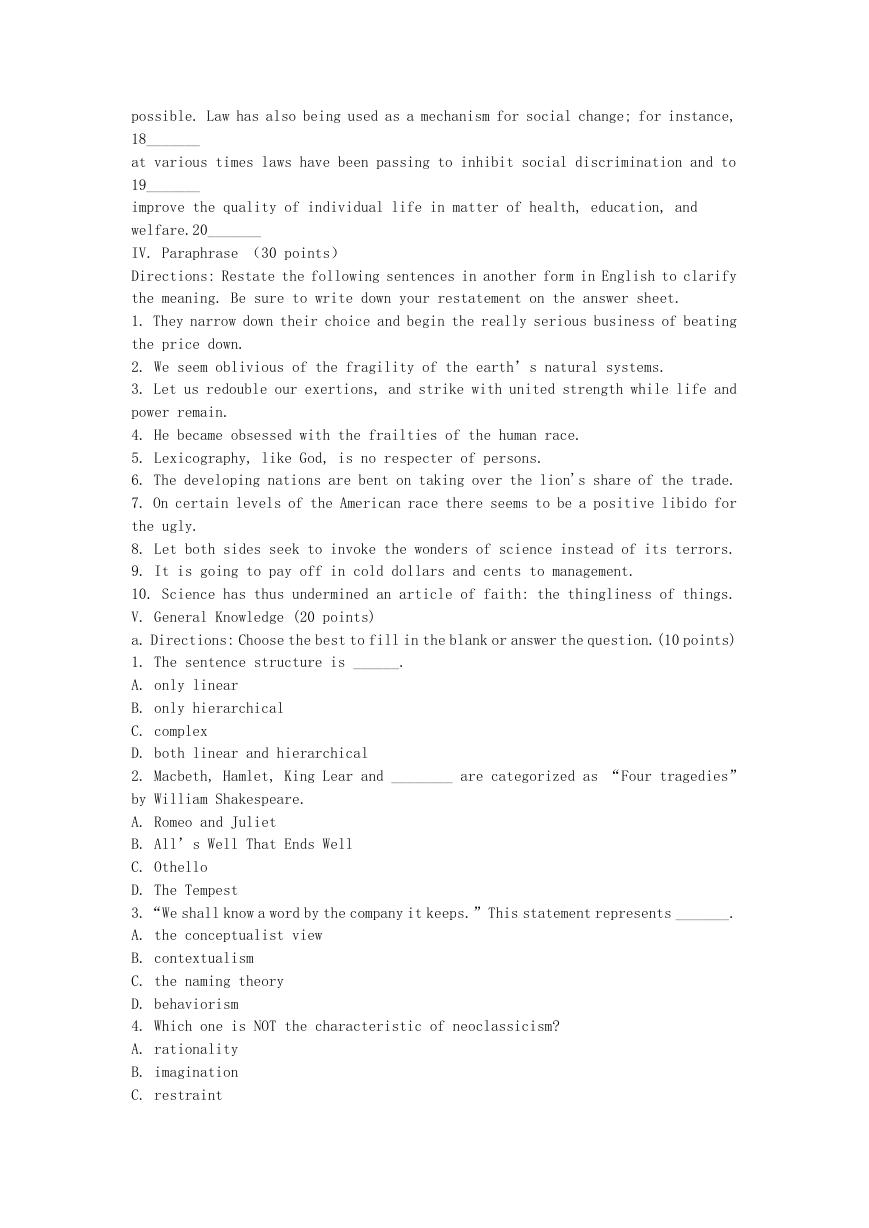

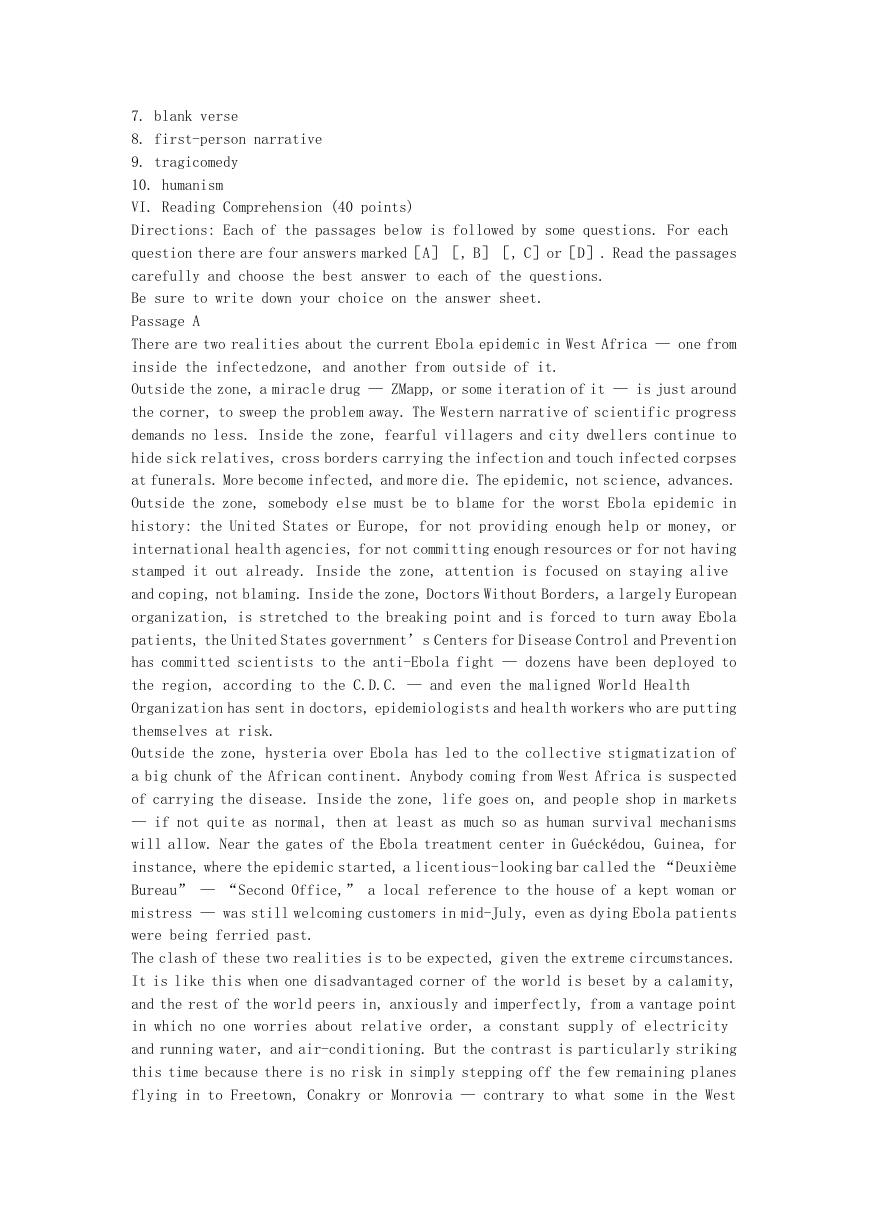
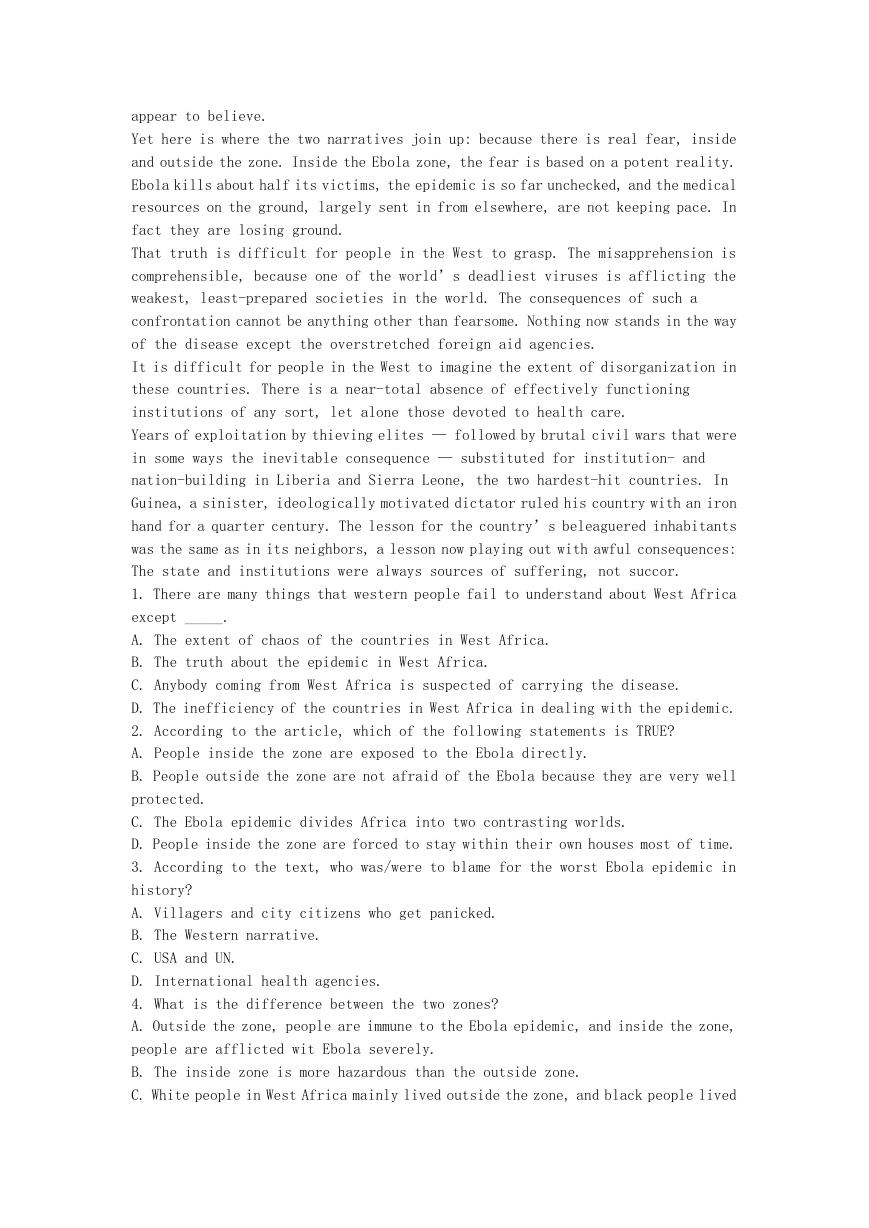
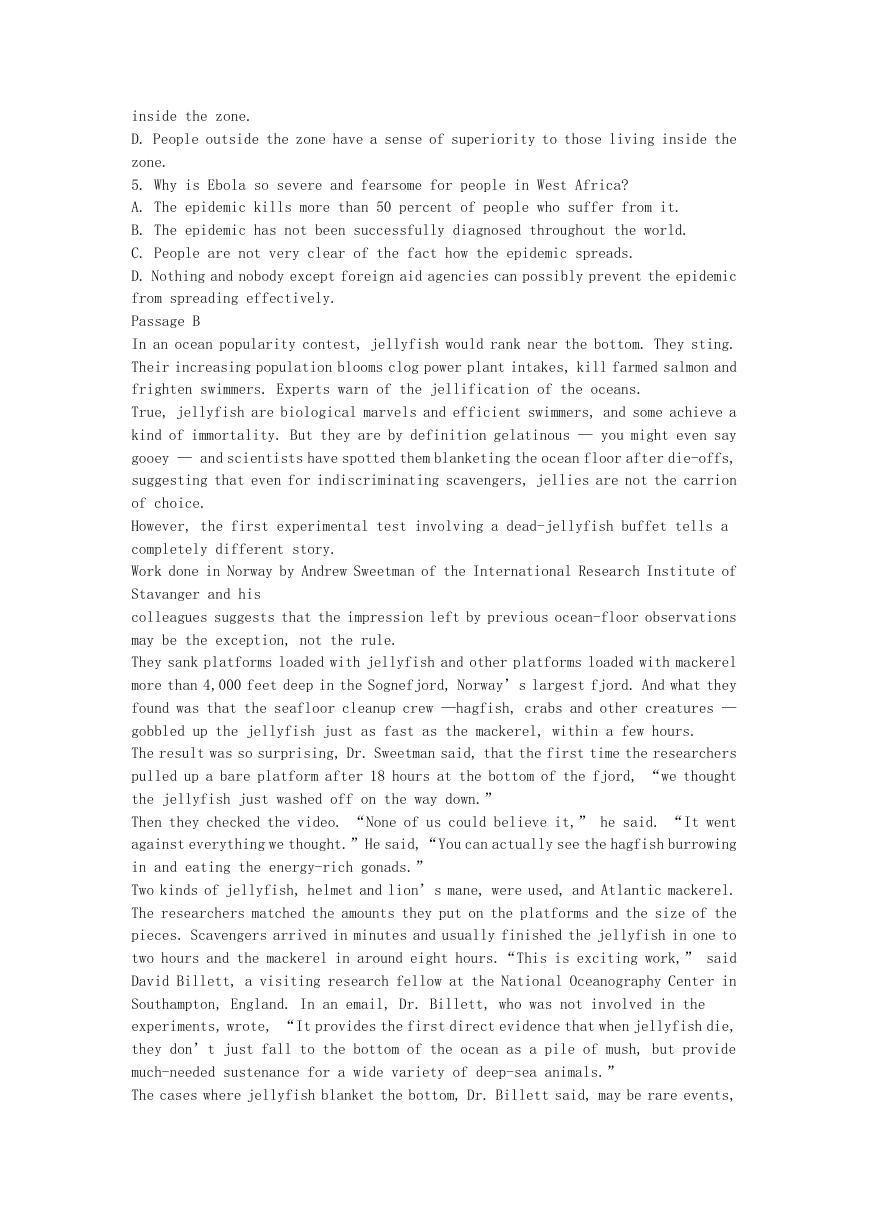








 2023年江西萍乡中考道德与法治真题及答案.doc
2023年江西萍乡中考道德与法治真题及答案.doc 2012年重庆南川中考生物真题及答案.doc
2012年重庆南川中考生物真题及答案.doc 2013年江西师范大学地理学综合及文艺理论基础考研真题.doc
2013年江西师范大学地理学综合及文艺理论基础考研真题.doc 2020年四川甘孜小升初语文真题及答案I卷.doc
2020年四川甘孜小升初语文真题及答案I卷.doc 2020年注册岩土工程师专业基础考试真题及答案.doc
2020年注册岩土工程师专业基础考试真题及答案.doc 2023-2024学年福建省厦门市九年级上学期数学月考试题及答案.doc
2023-2024学年福建省厦门市九年级上学期数学月考试题及答案.doc 2021-2022学年辽宁省沈阳市大东区九年级上学期语文期末试题及答案.doc
2021-2022学年辽宁省沈阳市大东区九年级上学期语文期末试题及答案.doc 2022-2023学年北京东城区初三第一学期物理期末试卷及答案.doc
2022-2023学年北京东城区初三第一学期物理期末试卷及答案.doc 2018上半年江西教师资格初中地理学科知识与教学能力真题及答案.doc
2018上半年江西教师资格初中地理学科知识与教学能力真题及答案.doc 2012年河北国家公务员申论考试真题及答案-省级.doc
2012年河北国家公务员申论考试真题及答案-省级.doc 2020-2021学年江苏省扬州市江都区邵樊片九年级上学期数学第一次质量检测试题及答案.doc
2020-2021学年江苏省扬州市江都区邵樊片九年级上学期数学第一次质量检测试题及答案.doc 2022下半年黑龙江教师资格证中学综合素质真题及答案.doc
2022下半年黑龙江教师资格证中学综合素质真题及答案.doc